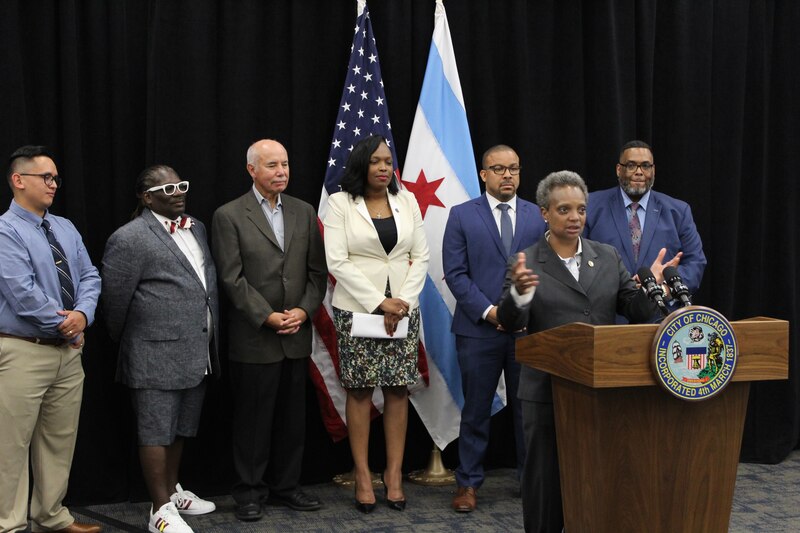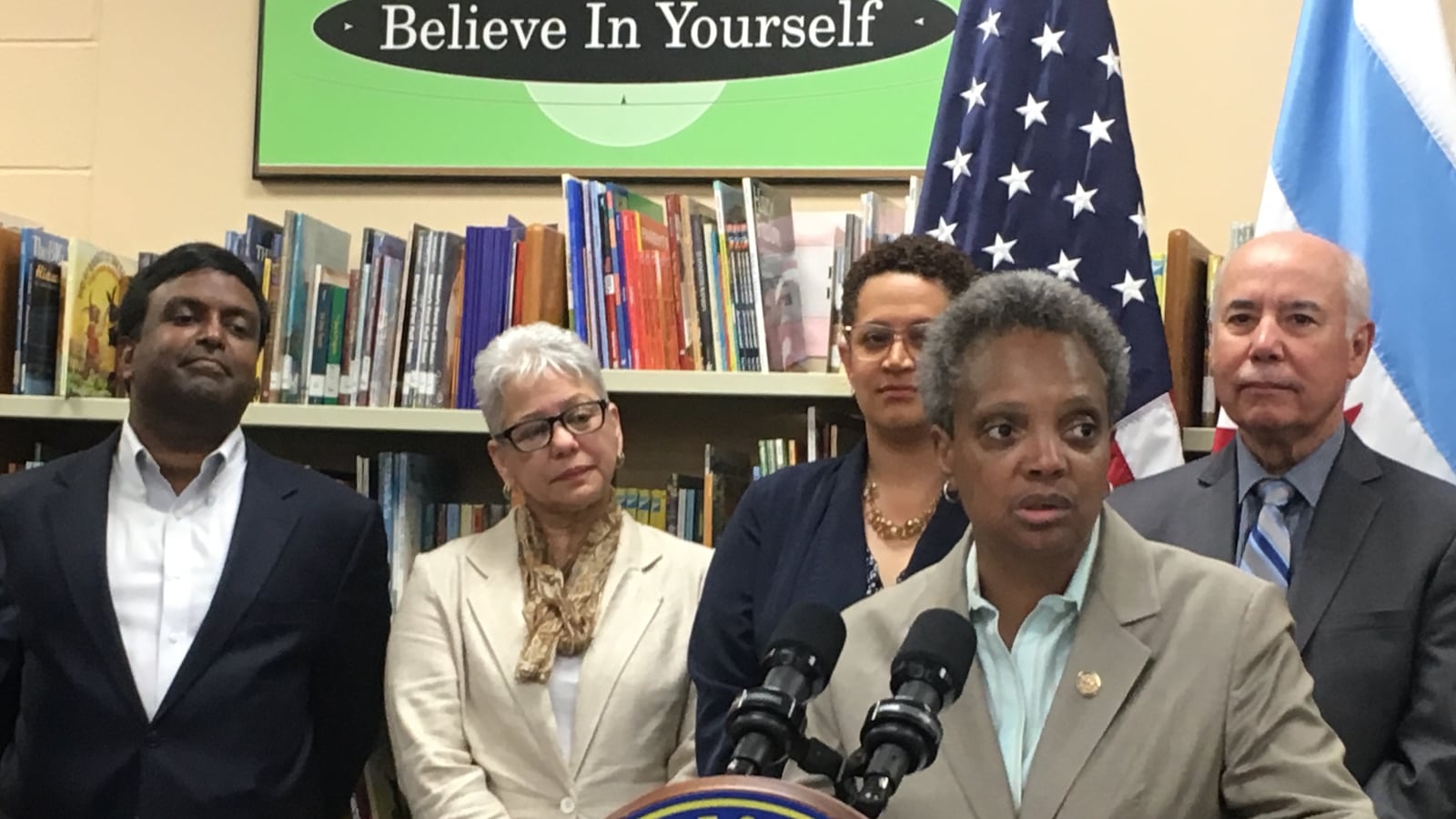Mayor Lori Lightfoot promised to reconsider how Chicago funds schools during the next school year and explore ways to spend more on students with the most need.
But that raises plenty of questions about how Chicago Public Schools will prioritize spending to be more equitable at the nation’s third-largest school district.
Lightfoot’s pledge came Tuesday as she spoke about a teacher recruiting and retention program. She proceeded to pledge more resources for schools and create hundreds of critical support staff positions without saying how she’d pay for it.
“The fortunes of CPS absolutely have improved,” Lightfoot said. “We feel comfortable this will fall within the resources we have.”
Related: Unlikely education allies press Mayor Lori Lightfoot to reform Chicago school funding
But while the district is on firmer financial footing than in recent years, thanks to a boost in state aid, it’s still paying off $8.4 billion in long-term debt. It runs an annual deficit and borrows to pay for day-to-day operations. How can it more equitably distribute the money it does have, all the while funding new programs, keeping others afloat and continuing to subsidize shrinking schools?
Here are five other big questions.

How will public engagement shape Chicago school funding reform?
How the district goes about public engagement will likely affect how critics — and Lightfoot’s school board — respond to a proposed funding overhaul. Lightfoot and school district leaders said they will listen to community members first. That’s plenty of time to hear from Chicago’s 77 community areas, but no small feat. School finance is pretty technical stuff, too, so an open question is how much the district will invest in public education around the issue.
Related: Chicago is changing its elementary school ratings. Here’s why educators are watching closely.
School board member Dwayne Truss recently voted no on an update to the district’s system for rating schools because he felt the district hadn’t adequately engaged teachers and families about the accountability policy. Truss was also a frequent critic of the district’s enrollment based budgeting approach before his appointment to the board in June, as a West Side activist and parent.
Last month, he told Chalkbeat during a recess at the board meeting, “A lot of issues at CPS are worth looking at again, including student-based budgeting.”
Will central office spending and structure be revisited, too?
Marguerite Roza, an education finance researcher studying weighted student funding models, suggested the district could restructure and downsize its bureaucracy if its looking to direct more funds into a needs-based school spending formula, including a 900-employee central office and another 230 employees supporting network offices throughout the city. The district also has another 4,600 employees on a citywide roster that support schools. Roza said the district could consider moving more centrally managed positions and dollars directly into schools, under principals’ purview.
Related: At more than $1 billion, Illinois tops the nation in school administration spending
Since the late 1980s, Chicago has leaned toward decentralization, putting decisions and budgeting into the hands of school leaders, an approach Roza credits in part for the district’s academic gains.
Compared with other big school districts, “Chicago still has a larger central office,” she said. “Does the next step mean moving more of that money out to schools, so people end up working in schools, not the central office or downtown?”
Will Chicago redistribute current dollars or only tap new funds for a needs-based formula?
There’s more than one way for Chicago to reform its student funding formula.
First, some background: Chicago uses weighted student funding, which allocates dollars based on individual student needs. Chicago provides some supplemental aid for students with disabilities, for those living in low-income households, and for schools with the highest concentrations of English language learners. The district also subsidizes schools with low or declining enrollment. But the bulk of schools’ budgets are funded based on how many students they have.
Related: Chicago is throwing its smallest high schools a lifeline. But is it enough?
The district could redistribute funds from its current formula by reducing its enrollment-based allocation, and adding more weights to its formula for high-needs student groups not currently accounted for such as refugees and students experiencing homelessness. But that could leave less money for schools with fewer high-need students.
“Low poverty schools could see budget cuts, and those would be difficult to deal with in the short term,” education finance researcher Ross Rubenstein said.
The district could also seek additional dollars to pour into an updated funding formula, but finding more money is easier said than done.
Related: Good news for some schools in $32 million push, but questions surface about whether process is fair
Leaders hope that the 2017 state funding reform law that sent more money to high-need districts like Chicago will continue to yield more funds. But that money isn’t in the bank yet, the state’s financial situation remains tepid and its unpaid bill backlog north of $6 billion. A lot depends on whether Gov. J.B. Pritzker’s graduated income tax plan passes. If Illinois provides more money for schools as the legislature has pledged, Chicago would be among the first in line to receive more: Chicago is only receiving 63 percent of the funding it should be getting, according to targets set by the state’s formula.
How will facilities money and planning for building repairs and upgrades factor in?
Capital funds accounted for $1 billion of the district’s $7.5 billion in spending last fiscal year, and parents have long complained about dilapidated school buildings.
Related: Nearly 40 Chicago schools, including charters, to get building boost from state capital plan
Every month, parents and advocates approach the podium to tell school board members about shoddy conditions, from leaky roofs and mold to out-of-date bathrooms and overcrowded classrooms. And at citywide public hearings last year on the capital budget, community members complained about not getting their fair share and argued the district’s capital investments should be more transparent and fair, even as others praised the district for investments in their school communities.
Related: Are there alternatives to closing schools? Chicago parents consider options.
Meanwhile, the district is playing catch-up on state requirements for an architectural needs assessments of school buildings. The school board recently approved a $5 million contract for a Maryland-based firm to conduct facility assessments of every building in the district within two years, and it faces an April 2021 deadline to update a 10-year facilities master plan.
How does the expired union contract impact the funding reform timeline?
Lightfoot’s negotiations with the Chicago Teachers Union will shape how the school district and principals spend their money. But the city and union haven’t come close to agreeing on teacher salaries, one of the district’s biggest costs and the largest slice of school budgets.
The union also wants Chicago to expand the $10 million-a-year community schools initiative to 55 more schools, and it’s not clear how that effort would be accounted for in a new funding formula. The school board last month approved a one-year expansion of the program.

